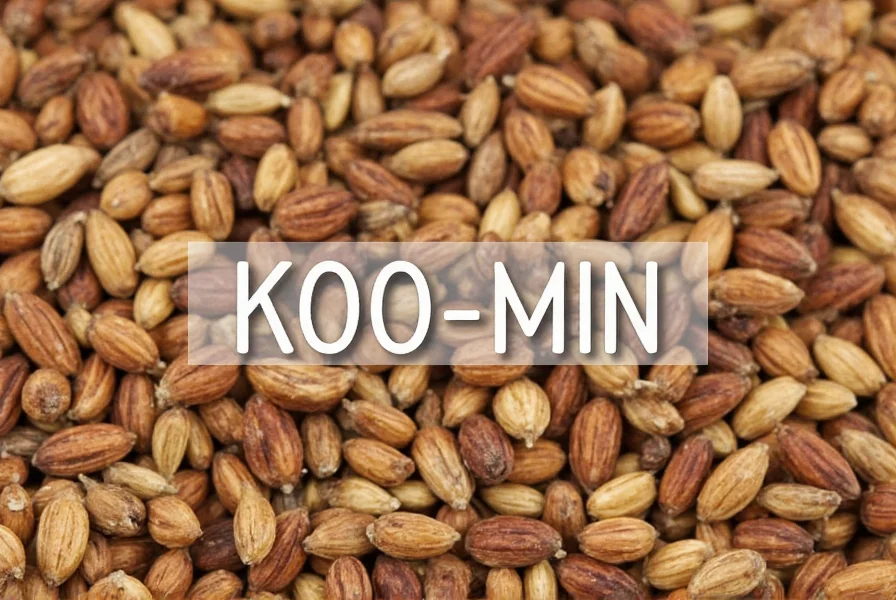Understanding how to correctly pronounce culinary terms enhances your cooking experience and communication in kitchen settings. When discussing recipes or shopping for ingredients, using the proper pronunciation of cumin ensures clarity and demonstrates culinary knowledge. This guide provides comprehensive information about cumin pronunciation, common mistakes to avoid, and linguistic context to help you say it correctly every time.
Phonetic Breakdown of Cumin Pronunciation
Let's examine the precise phonetic elements that make up the correct cumin pronunciation:
| Representation | Pronunciation Guide | Description |
|---|---|---|
| Standard English | KOO-min | First syllable rhymes with "zoo," second syllable like "in" in "begin" |
| IPA (International Phonetic Alphabet) | /ˈkuːmɪn/ | koo-min with stress on first syllable |
| Syllable Breakdown | KOO • min | Two distinct syllables with primary stress on first |
Audio Reference Description
While actual audio isn't included here, imagine hearing the word spoken by a native English speaker: the first syllable sounds identical to the word "coo" (as in pigeon sounds), followed immediately by "min" as in "minimize" without the "i" sound emphasis. The transition between syllables is smooth, with no pause or hard break.

Common Cumin Mispronunciations and Why They're Incorrect
Many people struggle with cumin pronunciation, leading to several common errors:
- 'CUH-min' (/ˈkʌmɪn/) - This incorrect version uses a short 'u' sound like in "cut". While common, this mispronunciation likely stems from confusing cumin with similar-looking words.
- 'KYOO-min' (/kjuːmɪn/) - Adding a 'y' sound before the 'oo' is unnecessary and doesn't match the word's etymology.
- 'CUM-in' (/kʌmɪn/) - This version drops the long 'oo' sound entirely, making it rhyme with "dumb" rather than "zoo".
These mispronunciations persist because cumin's spelling doesn't immediately suggest its correct pronunciation to English speakers. The 'u' following the 'c' creates confusion since 'c' typically makes a 'k' sound before 'a', 'o', or 'u', but the vowel combination here follows different linguistic rules.
Linguistic Origins of Cumin
Understanding cumin's etymology helps explain its pronunciation. The word entered English through Latin cuminum and Greek kyminon, ultimately tracing back to the Hebrew word камmōn. When adopted into English, the pronunciation evolved to 'KOO-min' rather than maintaining the original 'ky' sound.
The spelling 'cumin' (sometimes seen as 'cummin') reflects its journey through multiple languages. The double 'm' version appeared in English texts as early as the 16th century but has largely fallen out of favor in modern usage, though it still influences some people's pronunciation attempts.
Using Cumin Correctly in Conversation
Here are examples of cumin used properly in culinary contexts with correct pronunciation:
- "For authentic Mexican mole, you'll need freshly toasted KOO-min seeds."
- "The recipe calls for one teaspoon of ground KOO-min, not curry powder."
- "When shopping for spices, ask for KOO-min seeds rather than confusing them with caraway."
Notice how the pronunciation fits naturally within these sentences without disrupting the flow of speech. The emphasis on the first syllable helps distinguish it from similar-sounding words.

Related Spice Pronunciations
If you're learning cumin pronunciation, you might also wonder about these related spices:
- Coriander - kuh-RYE-an-der (not core-ee-an-der)
- Cilantro - si-LAN-tro (the Spanish term for coriander leaves)
- Cardamom - KAR-duh-mum (not car-DAH-mom)
- Paprika - puh-PREE-kuh (not pap-REE-kuh)
Learning these related pronunciations creates a more comprehensive understanding of culinary terminology and prevents confusion when discussing recipes or shopping for ingredients.
Regional Variations in Cumin Pronunciation
While 'KOO-min' represents the standard American and British English pronunciation, some regional variations exist:
- In Indian English, you might hear 'KOO-min' with a slightly softer 'n' sound
- Some Caribbean pronunciations emphasize both syllables more equally: 'KOO-MIN'
- Certain regional American accents might soften the 'oo' sound slightly toward 'kuh-MIN' while still maintaining the long vowel
These variations remain recognizable as referring to the same spice, but the 'KOO-min' pronunciation remains the most widely accepted standard in professional culinary contexts.
Practical Tips for Mastering Cumin Pronunciation
Here are effective techniques to ensure you always pronounce cumin correctly:
- Memory association - Link 'cumin' with 'zoo min' (as in animals at the zoo)
- Syllable counting - Practice saying 'KOO' (1) 'min' (2) with emphasis on the first
- Recording yourself - Compare your pronunciation with reliable sources
- Contextual usage - Practice using the word in recipe discussions
- Peer feedback - Ask cooking-savvy friends to correct your pronunciation
With consistent practice using these methods, correct cumin pronunciation will become second nature in your culinary vocabulary.
Frequently Asked Questions About Cumin Pronunciation
How do you pronounce cumin in British English?
In British English, cumin is pronounced 'KOO-min' (/ˈkuːmɪn/), identical to American English pronunciation. The first syllable uses a long 'oo' sound as in 'zoo', with emphasis on the initial syllable. Some regional British accents might slightly soften the 'oo' sound, but the fundamental pronunciation remains consistent across English-speaking regions.
Is it correct to say 'cummin' instead of 'cumin'?
While 'cummin' (with double m) appears in historical English texts and some regional dialects, the standard modern spelling is 'cumin' with a single m. The pronunciation remains 'KOO-min' regardless of spelling variations. Using 'cummin' spelling today might cause confusion, as it's considered archaic, though the pronunciation doesn't change with the extra 'm'.
Why do people often mispronounce cumin as 'CUH-min'?
People commonly mispronounce cumin as 'CUH-min' because English spelling conventions suggest a short 'u' sound after 'c' (as in 'cup' or 'cut'). However, cumin follows different linguistic rules due to its etymological origins. The word entered English from Latin and Greek, where the vowel combination produces a long 'oo' sound rather than the expected short 'u' based on typical English spelling patterns.
How is cumin pronounced in Spanish-speaking countries?
In Spanish, cumin is 'comino' (coh-MEE-noh), with emphasis on the second syllable. This differs significantly from English pronunciation. When English speakers refer to the spice in international culinary contexts, they typically use the English 'KOO-min' pronunciation rather than attempting the Spanish version, unless specifically discussing Spanish-language recipes or contexts.
Does the pronunciation change when referring to ground cumin versus cumin seeds?
No, the pronunciation remains 'KOO-min' whether referring to ground cumin or cumin seeds. The form of the spice doesn't affect pronunciation. You would say 'KOO-min seeds' and 'ground KOO-min' using identical pronunciation for the spice name itself. This consistency helps avoid confusion when discussing different preparations of the same spice.











 浙公网安备
33010002000092号
浙公网安备
33010002000092号 浙B2-20120091-4
浙B2-20120091-4